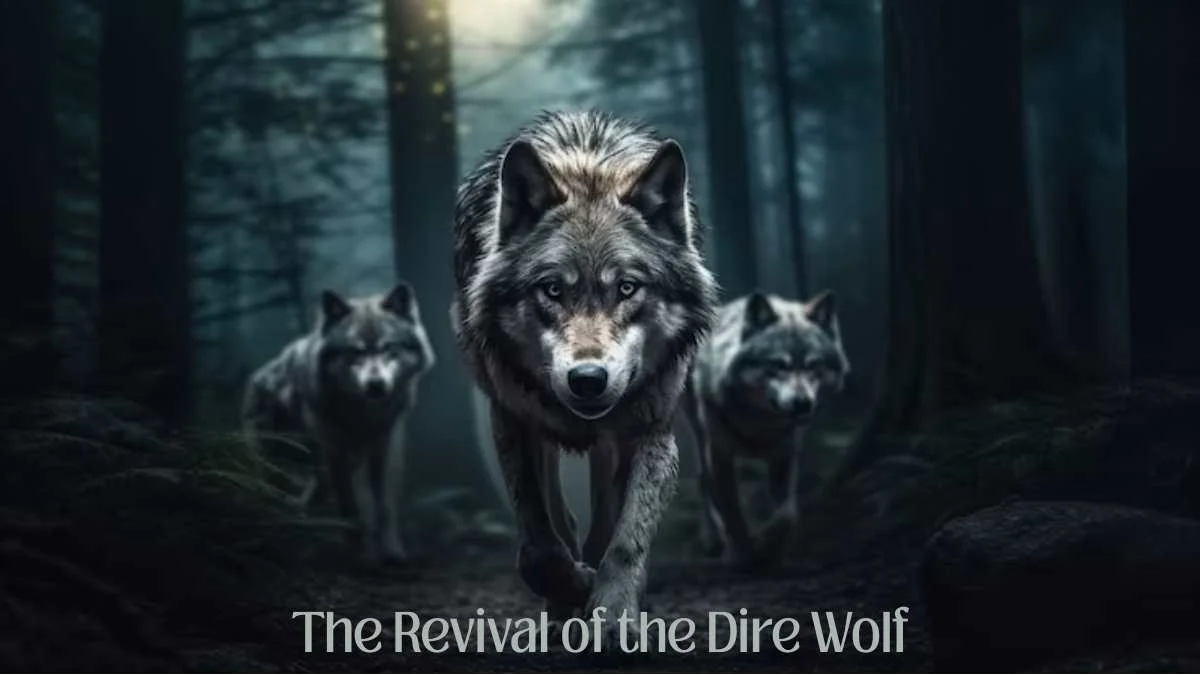GENERAL
Dire Wolf Comeback: How Genetic Science Is Resurrecting a Lost Predator

Biotechnology pioneers have established extinct species revival as an ambitious field of study, where the dire wolf (Aenocyon dirus) leads this scientific achievement. During the Pleistocene age, the massive predators roamed through the Americas before their extinction around 10,000 years back. Scientists now attempt to resurrect this famous creature through the advancements of genetic engineering technology. Research incorporates ancient DNA extraction followed by DNA editing using modern wolf genetic material for blueprint construction and implementation of CRISPR tools to add desired traits. The article explores the genetic engineering process that makes possible the revival of the dire wolf species.
What Was the Dire Wolf?
The dire wolf (Aenocyon dirus) represented a bigger and heavier evolution of present-day gray wolves. The apex predators reached 150 pounds in weight while maintaining a shoulder height of 30 inches. The jaw power and tooth strength of dire wolves surpassed contemporary wolves because they needed their enhanced hunting abilities to pursue mastodon and bison prey. These wolf-like creatures spread across both North and South American territories throughout the Pleistocene Epoch. Climate change, alongside the loss of their main prey, led to their demise because they lacked sufficient adaptability in the altered conditions.
The Science Behind De-Extinction
Research into de-extinction uses genetic engineering as its main method for reviving species which become extinct. This process lets scientists make new species through DNA analysis of preserved fossils and ancient remains. CRISPR gene editing serves as one of the main technological methods scientists use to perform specific modifications to DNA sequences. Researcher study genetic differences between modern species and their extinct ancestors to allow contemporary organisms to display traits from extinct species through genetic modifications. Scientists aim to reintroduce dire wolves together with other extinct species to enhance biodiversity and normalize ecological systems.
How Genetic Engineering Is Used to Revive the Dire Wolf
Scientists apply CRISPR technology to modern gray wolf gene sequences to restore the dire wolf species. Science experts begin their research by extracting ancient dire wolf DNA from preserved specimens, which helps them locate genetic distinctions between these extinct animals and contemporary wolf species. By inserting these genetic markers into the modern wolf DNA, scientists can generate hybrids that display features like enlarged skulls and stronger mandibles, and heavier body structures that resemble the extinct dire wolf. Genetically engineered wolves retain select traits from the extinct dire wolf through this approach, although they do not exactly duplicate the original animal.
Colossal Biosciences and Their Role in the Project
The dire wolf revival project operates under the leadership of Colossal Biosciences at the cutting edge of de-extinction biological science. The organization remains famous for its mammoth resurrection program yet has now teamed up with geneticists and conservationists to revive the dire wolf. CRISPR gene editing allows Colossal Biosciences to create genetically modified wolf pups from gray wolves by applying extinct predator genetic traits to the wolves during CRISPR procedures. Romulus, Remus, and Khaleesi are examples of these engineered pups. Through its dire wolf restoration project, Colossal seeks to demonstrate the possibilities of de-extinction technology as a conservation tool for biodiversity heritage while striving to revive this extinct animal.
The First Dire Wolf Pups: Romulus, Remus, and Khaleesi
Through its early 2025 achievement, Colossal Biosciences delivered three wolf pups named Romulus, Remus, and Khaleesi, thus advancing the dire wolf revival process. The pups emerged from DNA modification of contemporary gray wolves to obtain extinct dire wolf characteristics such as enlarged skulls, strengthened jaws, and enhanced body capacity. These animals link genetically to the Pleistocene predator through wolf genetic modification, although they did not inherit the exact clone DNA from the extinct species. The successful creation proves the power of genetic engineering to restore vanished species and shows what wildlife preservation may look like in the future.
The Ethical Implications of Bringing Back Extinct Species
The process of reviving extinct animals, particularly the dire wolf, triggers substantial ethical problems. Some scientists believe genetic engineering of extinct species could disrupt natural habitats, thus causing environmental risks. The genetic modifications made to revived animals might not be sufficient for their survival in contemporary environments while affecting their overall welfare. The current focus should be on saving endangered species that remain alive while ignoring attempts to revive species which already disappeared from existence. The necessary debate shows how scientists need to walk a razor-thin line between technological advancement and environmental sustainability.
Can Genetic Engineering Truly Bring Back the “Real” Dire Wolf?
The main concern regarding dire wolf revival through genetic engineering focuses on whether scientists can duplicate authentic examples of extinct species. The answer is complex. Through genetic engineering, researchers can reproduce some physical traits from the dire wolf, but the produced animals remain different from their original ancestors. The ancient DNA that scientists study frequently exists as broken fragments that prevent scientists from recovering the complete original genome sequence. The restored wolves contain elements from gray wolf genetics, but their modified DNA does not mimic the complete dire wolf species. The authenticity of these de-extinction procedures faces uncertainty because of these issues.

The Potential Ecological Impact of Reviving the Dire Wolf
Restoring the dire wolf population would bring forth extensive environmental changes that would show both beneficial and adverse effects. Historically, dire wolves functioned as top predators, which helped shape the populations of big herbivores to maintain ecological stability in the environment. The extinction of dire wolves occurred a long time ago, during which modern ecosystems changed extensively, so bringing back this species could affect existing wildlife communities. After its reintroduction, the revived species might face difficulties because it will lack natural prey and must compete with other carnivores in its environment. The evaluation of ecological impacts resulting from reintroduction must happen before any decisions to let them roam free in the wild because present ecosystems are delicate.
Why Are Scientists Interested in Reviving the Dire Wolf?
The revival of the dire wolf represents one aspect of scientific de-extinction research that focuses on both biodiversity recovery and natural ecosystem balance restoration. Scientists work to resurrect dire wolves because they want to learn more about ancient ecosystems, along with the predator role they served. De-extinction procedures present the potential to solve contemporary environmental problems stemming from apex predator population decreases along with their ecological consequences. Controversially, the revival of dire wolves can function as a conservation method that preserves extinct ecosystem functions while boosting biodiversity.
The Controversy Over Funding De-Extinction Projects
The funding of de-extinction projects, such as the revival of the dire wolf, is highly controversial. Critics argue that the resources spent on these projects could be better used for the conservation of endangered species and habitat protection. The high costs associated with genetic engineering, laboratory research, and the reintroduction of species into the wild raise concerns about whether these funds are well spent. Additionally, some believe that focusing on extinct species detracts from efforts to address the root causes of biodiversity loss, such as habitat destruction and climate change. This ongoing debate highlights the priorities of modern conservation science.
Conclusion
The project to resurrect dire wolves through genetic engineering combines progressive science methods with substantial moral concerns while remaining a subject of active debate. The successful reproduction of genetically engineered pups Romulus, Remus, and Khaleesi represents an important scientific accomplishment that still leaves many questions about reviving extinct creatures unresolved. Scientists still need to investigate how both ecological systems and the authenticity of revived animal populations will shape up. The modern era demands careful evaluation of resurrecting prehistoric predators like the dire wolf and their effects on our surrounding world because we now harness genetic technology to its fullest extent.
-

 BIOGRAPHY7 months ago
BIOGRAPHY7 months agoBehind the Scenes with Sandra Orlow: An Exclusive Interview
-

 HOME1 year ago
HOME1 year agoDiscovering Insights: A Deep Dive into the //vital-mag.net blog
-

 HOME1 year ago
HOME1 year agoSifangds in Action: Real-Life Applications and Success Stories
-

 BIOGRAPHY1 year ago
BIOGRAPHY1 year agoThe Woman Behind the Comedian: Meet Andrew Santino Wife




























